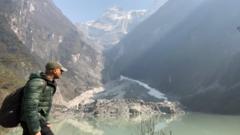In the heart of Nepal, the Himalayas—the stunning mountain range that draws thousands of trekkers—are becoming increasingly elusive. The once-pristine views from cities like Kathmandu and popular spots like Nagarkot are now obscured by thick, persistent haze. This troubling trend is largely attributed to severe air pollution caused by a combination of dust, smoke, and the effects of climate change.
Having spent my youth in the shadow of the Himalayas, each return visit to Kathmandu is tinged with disappointment as the iconic peaks remain hidden from view. On a recent trip, even a hotel at significant elevation failed to provide the promised vistas, with haze rendering visibility nearly nonexistent throughout my two-week stay.
"Since the haze has become a fixture, I've shifted my hotel's brand away from the once-coveted views of sunrise, sunset, and the Himalayas," shared Yogendra Shakya, a hotelier from Nagarkot. He has adapted to changing conditions by emphasizing history and cultural experiences to attract visitors.
Similarly, Lucky Chhetri, a veteran trekking guide in Nepal, lamented a staggering 40% decline in her business due to the diminishing visibility of the mountains. Tourists are expressing their disappointment in increasing numbers. An Australian visitor, John Carrol, noted, "The mountains were my reason for coming; not being able to see them is profoundly disappointing."
Scientists assert that the haze's severity and duration are worsening, significantly hampering visibility during what used to be the best trekking seasons—spring and fall. The phenomenon is exacerbated by rising temperatures and a lack of rain, with haze often settling in as early as December.
Though some trekking operators might change professions due to these challenges, the region's tourism industry still hopes for better days. Malika Virdi, who runs a community-based tourism business in India’s Uttarakhand state, noted that tourists remain persistent despite the haze, seeking the elusive views of the mountains.
In the broader context of South Asia, air pollution often ranks among the world's highest. Major urban centers grapple with toxic air that disrupts travel and daily life, while sources like vehicular emissions, open burning of waste, and forest fires further contribute to the region’s plight.
The situation has become dire enough that researchers like Dr. Someshwor Das are predicting a continued rise in haze and dust storms due to ongoing climate changes. Notably, the number of hazy days has surged dramatically at key tourist locations, with records showing a jump from 23 hazy days in 2020 to an alarming 168 in 2024.
The future of the Himalayas, even as breathtaking as it has been, seems to be fading—leaving communities that rely heavily on tourism to grapple with guilt when unable to deliver what visitors came to see. For many, the beautiful mountains may soon only be glimpsed through photographs, paintings, or postcards, rather than in person—forever lost in the haze.
Having spent my youth in the shadow of the Himalayas, each return visit to Kathmandu is tinged with disappointment as the iconic peaks remain hidden from view. On a recent trip, even a hotel at significant elevation failed to provide the promised vistas, with haze rendering visibility nearly nonexistent throughout my two-week stay.
"Since the haze has become a fixture, I've shifted my hotel's brand away from the once-coveted views of sunrise, sunset, and the Himalayas," shared Yogendra Shakya, a hotelier from Nagarkot. He has adapted to changing conditions by emphasizing history and cultural experiences to attract visitors.
Similarly, Lucky Chhetri, a veteran trekking guide in Nepal, lamented a staggering 40% decline in her business due to the diminishing visibility of the mountains. Tourists are expressing their disappointment in increasing numbers. An Australian visitor, John Carrol, noted, "The mountains were my reason for coming; not being able to see them is profoundly disappointing."
Scientists assert that the haze's severity and duration are worsening, significantly hampering visibility during what used to be the best trekking seasons—spring and fall. The phenomenon is exacerbated by rising temperatures and a lack of rain, with haze often settling in as early as December.
Though some trekking operators might change professions due to these challenges, the region's tourism industry still hopes for better days. Malika Virdi, who runs a community-based tourism business in India’s Uttarakhand state, noted that tourists remain persistent despite the haze, seeking the elusive views of the mountains.
In the broader context of South Asia, air pollution often ranks among the world's highest. Major urban centers grapple with toxic air that disrupts travel and daily life, while sources like vehicular emissions, open burning of waste, and forest fires further contribute to the region’s plight.
The situation has become dire enough that researchers like Dr. Someshwor Das are predicting a continued rise in haze and dust storms due to ongoing climate changes. Notably, the number of hazy days has surged dramatically at key tourist locations, with records showing a jump from 23 hazy days in 2020 to an alarming 168 in 2024.
The future of the Himalayas, even as breathtaking as it has been, seems to be fading—leaving communities that rely heavily on tourism to grapple with guilt when unable to deliver what visitors came to see. For many, the beautiful mountains may soon only be glimpsed through photographs, paintings, or postcards, rather than in person—forever lost in the haze.




















